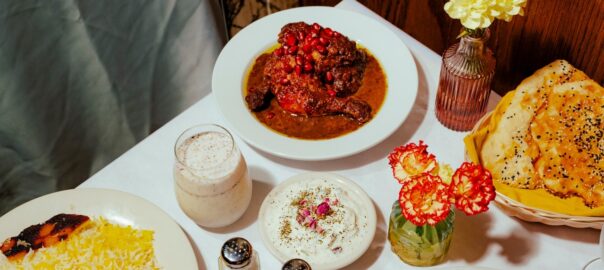[ad_1]
Rice—along with grilled peppers and tomatoes, raw red onion, and fresh basil—also accompanied the menu’s kebabs: koobideh, made with a combination of ground lamb and beef, and juicy chunks of boneless chicken, marinated in saffron and lemon juice. Rice was wonderful mixed with Rejali’s yogurt dips: the thicker, more sour mast mosir, made with Persian shallots and nigella seeds, and the sweeter mast khiar, with cucumber, raisins, sunflower seeds, dried mint, and dried rose petals. For Rejali’s superlative dolmeh barg mo, which she makes according to her mother’s recipe, rice was wrapped—with yellow split peas, barberries, tarragon, basil, cilantro, and onion—in silky grape leaves, simmered in pomegranate molasses, and served warm.
For the zereshk polo ba morgh (left), chicken braised in tomato and saffron is blanketed in basmati rice. The chelo khoresh-e ghormeh sabzi (right) is made with fried herbs, braised beef, kidney beans, and sun-dried limes.
There were dishes without rice, too, including kuku sabzi—which is sometimes likened to a frittata but could also be described as a heap of herbs (dill, cilantro, parsley) combined with barberries, garlic, and walnut and held together by a bit of egg—and mirza ghasemi, a luscious eggplant-and-tomato dip topped with a fried egg and accompanied by freshly baked flatbread. Most patrons were not dressed in rice-eating clothes; more than one was wearing scrubs. But the marble-walled dining room, on the second floor of a century-old town house, is imbued with a certain formality, a faded glamour befitting the preservation of this ancient and enduring cuisine. (Dishes $9-$30.) ♦
[ad_2]
Source link
